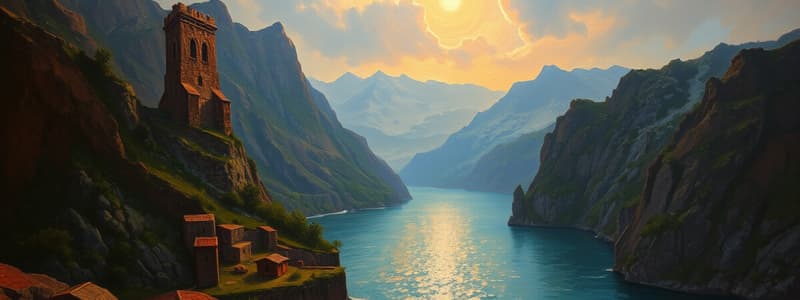Podcast
Questions and Answers
What is a primary force driving the process of continental drift?
What is a primary force driving the process of continental drift?
- Magnetic reversal
- Tidal forces from the sun
- Gravitational pull from the moon
- Convection currents in the mantle (correct)
Which statement accurately describes sea floor spreading?
Which statement accurately describes sea floor spreading?
- It involves the creation of new oceanic crust at divergent boundaries. (correct)
- It leads to the subduction of continental plates.
- It occurs at convergent plate boundaries.
- It is primarily responsible for earthquake formation.
Which type of plate boundary is associated with the formation of mountain ranges?
Which type of plate boundary is associated with the formation of mountain ranges?
- Divergent boundaries
- Subduction zones
- Convergent boundaries (correct)
- Transform boundaries
What evidence supports the theory of continental drift?
What evidence supports the theory of continental drift?
Which plate is considered a minor tectonic plate?
Which plate is considered a minor tectonic plate?
Flashcards are hidden until you start studying
Study Notes
Continental Drift
- Proposed by Alfred Wegener in 1912, suggesting continents were once a single landmass (Pangaea) that gradually drifted apart.
- Supported by fossil evidence, geological similarities, and paleoclimate data.
Evidences to Support Continental Drift
- Fossil records of identical species found on different continents, indicating they were once connected.
- Similar rock formations and mountain ranges across continents, such as the Appalachian and Caledonian mountains.
- Glacial deposits and scratched bedrock in now-tropical regions, suggesting historical movement.
Forces of Drifting
- Mantle convection, where heat from Earth's interior causes mantle rocks to flow, driving continental movement.
- Gravity, which pulls oceanic plates downward at subduction zones, aiding in movement.
Post Drift Studies
- Studies conducted on diverging and converging plate boundaries to understand dynamic earth processes.
- Investigations into how continental drift has influenced global climate and biodiversity over time.
Ocean Floor Configuration
- Ocean floors consist of mid-ocean ridges, abyssal plains, trenches, and seamounts.
- Mapping through sonar technology has revealed underwater features that correlate with plate tectonic activities.
Distribution of Volcanoes and Earthquakes
- Concentrated along plate boundaries; divergent boundaries create new crust and volcanic activity, while convergent boundaries lead to subduction and earthquake hotspots.
- Ring of Fire in the Pacific Ocean illustrates a major zone of seismic and volcanic activity.
Concept of Sea Floor Spreading
- Proposed by Harry Hess in the 1960s, explaining how new oceanic crust is created at mid-ocean ridges as tectonic plates pull apart.
- Evidence includes magnetic striping on the ocean floor and age differentiation of oceanic rocks.
Plate Tectonics
- Earth’s lithosphere is divided into tectonic plates that float on the viscous asthenosphere beneath.
- Interactions between plates generate geological phenomena including earthquakes, mountains, and oceanic trenches.
Major and Minor Plates
- Major plates include the Pacific, North American, Eurasian, South American, African, Antarctic, and Indo-Australian plates.
- Minor plates consist of smaller sections like the Nazca, Cocos, and Caribbean plates.
Types of Plate Boundaries
- Convergent boundaries (plates collide), divergent boundaries (plates separate), and transform boundaries (plates slide past one another).
- Each type is characterized by distinct geological features and processes.
Rates of Plate Movement
- Average movement ranges from a few millimeters to several centimeters per year.
- Variations depend on specific plate interactions and geophysical processes.
Forces of Plate Movement
- Slab pull (the weight of a sinking plate helps pull the rest down), ridge push (underlying heat causes uplift at mid-ocean ridges), and mantle convection.
Movement of the Indian Plate
- The Indian Plate is moving northward towards the Eurasian Plate, causing the uplift of the Himalayas and frequent earthquake activity in the region.
- This movement is influenced by the speed of tectonic processes and surrounding plate dynamics.
Studying That Suits You
Use AI to generate personalized quizzes and flashcards to suit your learning preferences.




